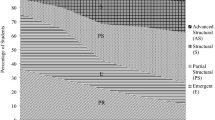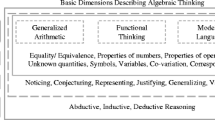Abstract
Recent educational research has turned increasing attention to the structural development of young students’ mathematical thinking. Early algebra, multiplicative reasoning, and spatial structuring are three areas central to this research. There is increasing evidence that an awareness of mathematical structure is crucial to mathematical competence among young children. The purpose of this paper is to propose a new construct, Awareness of Mathematical Pattern and Structure (AMPS), which generalises across mathematical concepts, can be reliably measured, and is correlated with general mathematical understanding. We provide supporting evidence drawn from a study of 103 Grade 1 students.
Similar content being viewed by others
References
Arcavi, A. (2003). The role of visual representations in the learning of mathematics.Educational Studies in Mathematics, 52, 215–241.
Battista, M. C. (1999). Spatial structuring in geometric reasoning.Teaching Children Mathematics, 6, 171–177.
Battista, M. T., Clements, D. H., Arnoff, J., Battista, K., & Borrow, C. (1998). Students’ spatial structuring of 2D arrays of squares.Journal for Research in Mathematics Education, 29, 503–532.
Biggs, J. B., & Collis, K. (1982).Evaluating the quality of learning: The SOLO taxonomy. New York: Academic Press.
Blanton, M., & Kaput, J. (2005). Characterizing a classroom practice that promotes algebraic reasoning.Journal for Research in Mathematics Education, 36, 412–446.
Booth, R. L. & Thomas, M. J. (2000). Visualization in Mathematics Learning: Arithmetic problem-solving and student difficulties.Journal of Mathematical Behavior, 18(2), 169–190.
Carraher, D. W., Schliemann, A. D., Brizuela, B. M., & Earnest, D. (2006). Arithmetic and algebra in early mathematics education.Journal for Research in Mathematics Education, 37, 87–115.
Clements, D. H., & Sarama, J. (2007). Effects of a preschool mathematics curriculum: Summative research on theBuilding Blocks project.Journal for Research in Mathematics Education, 38, 136–163.
Cobb, P., Gravemeijer, K., Yackel, E., McClain, K., & Whitenack, J. (1997). Mathematizing and symbolizing: The emergence of chains of signification on one first-grade classroom. In D. Kirshner & J. A. Whitson (Eds.),Situated cognition: Social, semiotic, and psychological perspectives (pp. 151–233). Mahwah, NJ: Lawrence Erlbaum.
Confrey, J., & Smith, E. (1995). Splitting, covariation, and their role in the development of exponential functions.Journal for Research in Mathematics Education, 26, 66–86.
Doig, B. (2005). Developing formal mathematical assessment for 4- to 8- year-olds.Mathematics Education Research Journal, 16(3), 100–119.
English, L. D. (1999). Assessing for structural understanding in children’s combinatorial problem solving.Focus on Learning Problems in Mathematics, 21(4), 63–82.
English, L. D. (2004). Promoting the development of young children’s mathematical and analogical reasoning. In L. D. English (Ed.),Mathematical and analogical reasoning of young learners. Mahwah, NJ: Lawrence Erlbaum.
English, L. D., & Watters, J. J. (2005). Mathematical modelling in third-grade classrooms.Mathematics Education Research Journal, 16(3), 59–80.
Goldin, G. A. (1998). Representational systems, learning, and problem solving in mathematics.Journal of Mathematical Behavior, 17, 137–166.
Gray, E., Pitta, D., & Tall, D. O. (2000). Objects, actions, and images: A perspective on early number development.Journal of Mathematical Behavior, 18, 401–413.
Howell, S., & Kemp, C. (2005). Defining number sense: A participatory Australian study.Educational Psychology, 25, 555–571.
Hunting, R. (2003). Part-whole number knowledge in preschool children.Journal of Mathematical Behavior, 22, 217–235.
Lamon, S. (1996). The development of unitizing: Its role in children’s partitioning strategies.Journal for Research in Mathematics Education, 27, 170–193.
Lehrer, R. (2007). Introducing students to data representation and statistics. In K. Milton, H. Reeves, & T. Spencer (Eds.),Mathematics: Essential for learning, essential for life (Proceedings of the 30th annual conference of the Mathematics Education Research Group of Australasia, Hobart, Vol. 1, pp. 22–41). Adelaide: AAMT.
Lehrer, R., & Lesh, R. (2003). Mathematical learning. In W. Reynolds & G. Miller (Eds.),Comprehensive handbook of psychology, Volume 7 (pp. 357–391). New York: Wiley.
Mason, J. (1996). Expressing generality and roots of algebra. In N. Bednarz, C. Kieran, & L. Lee (Eds.),Approaches to algebra (pp. 65–86). Dordrecht, The Netherlands: Kluwer.
Mulligan (2002). The role of structure in children’s development of multiplicative reasoning. In B. Barton, K. C. Irwin, M. Pfannkuch, & M. O. Thomas (Eds.),Mathematics Education in the South Pacific (Proceedings of the 25th annual conference of the Mathematics Education Research Group of Australasia, Auckland, NZ, Vol. 2, pp. 497–503). Sydney: MERGA.
Mulligan, J. T., English, L. D., & Mitchelmore, M. C. (2008). Reconceptualising early mathematics learning: An evaluation study. In O. Figueras, J. Cortina, S. Alatorre, T. Rojano & A. Sepúlveda (Eds.),Proceedings of the Joint Meeting of PME 32 and PME-NA XXX (Vol. 1, p. 293). México: Cinvestav-UMSNH.
Mulligan, J. T., & Mitchelmore, M. C. (1997). Young children’s intuitive models of multiplication and division.Journal for Research in Mathematics Education, 28, 309–331.
Mulligan, J., Mitchelmore, M. C., Marston, J., Highfield, K., & Kemp, C. (2008). Promoting mathematical pattern and structure in the first year of schooling: An intervention study. In O. Figueras, J. Cortina, S. Alatorre, T. Rojano & A. Sepúlveda (Eds.),Proceedings of the Joint Meeting of PME 32 and PME-NA XXX (Vol. 4, pp. 129–136). México: Cinvestav-UMSNH.
Mulligan, J. T., Mitchelmore, M. C., Outhred, L. N., & Russell, S. (1997). Second graders’ representations and conceptual understanding of number. In F. Biddulp & K. Carr (Eds.),People in mathematics education (Proceedings of the 20th annual conference of the Mathematics Education Research Group of Australasia Rotorua, NZ, Vol. 1, pp. 361–368). Sydney: MERGA
Mulligan, J., Mitchelmore, M., & Prescott, A. (2005). Case studies of children’s development of structure in early mathematics: A two-year longitudinal study. In H. L. Chick & J. L. Vincent (Eds.),Proceedings of the 29th conference of the International Group for the Psychology of Mathematics Education (Vol. 4, pp. 1–9). Melbourne: Program Committee.
Mulligan, J. T., Prescott, A., Papic, M., & Mitchelmore, M. C. (2006). Improving early numeracy through a Pattern and Structure Mathematics Awareness Program (PASMAP). In P. Grootenboer, R. Zevenbergen & M. Chinnappan (Eds.),Identities, cultures and learning spaces (Proceedings of the 29th annual conference of the Mathematics Education Research Group of Australasia, Canberra, Vol. 2, pp. 376–383). Adelaide: MERGA.
Mulligan, J. T., & Vergnaud, G. (2006). Research on children’s early mathematical development: Towards integrated perspectives. In A. Gutiérrez & P. Boero (Eds.),Handbook of research on the psychology of mathematics education: Past, present and future (pp. 261–276). London: Sense Publishers.
Mulligan, J. T., & Watson J. M., (1998). A developmental multi-modal model for multiplication and division.Mathematics Education Research Journal, 10(2), 61–86.
Mulligan, J. T., & Wright, R. J. (2000). An assessment framework for early multiplication and division. In T. Nakahara & M. Koyama (Eds.),Proceedings of the 24th Conference of the International Group for the Psychology of Mathematics Education (Vol. 4, pp. 17–25). Hiroshima: Program Committee.
NSW Department of Education & Training. (2001).Count Me In Too: Professional development package. Sydney: Author.
Outhred, L., & Mitchelmore, M. C. (2000). Young children’s intuitive understanding of rectangular area measurement.Journal for Research in Mathematics Education, 31, 144–168.
Papic, M., & Mulligan, J. T. (2007). The growth of early mathematical patterning: An intervention study. In J. Watson, & K. Beswick (Eds.),Mathematics: Essential research, essential practice (Proceedings of the 30th annual conference of the Mathematics Education Research Group of Australasia, Hobart, Vol. 2, pp. 591–600). Adelaide: MERGA.
Piaget, J. (1970).Structuralism. New York: Harper & Row.
Pitta-Pantazi, D., Gray, E., & Christou, C. (2004). Elementary school students’ mental representations of fractions. In Høines, M.J & Fuglestad, A. (Eds.),Proceedings of the 28th annual conference of the International Group for the Psychology of Mathematics Education (Vol. 4, pp. 41–48). Bergen, Norway: Bergen University College.
Slovin, H., & Dougherty, B. (2004). Children’s conceptual understanding of counting. In M. J. Høines & A. B. Fuglestad (Eds.),Proceedings of the 28th conference of the International Group for the Psychology of Mathematics Education (Vol. 4, pp. 209–216). Bergen, Norway: Bergen University College.
Steffe, L. (1994). Children’s multiplying schemes. In G. Harel & J. Confrey (Eds.),The development of multiplicative reasoning in the learning of mathematics (pp. 3–41). Albany, NY: State University of New York Press.
Thomas, N. & Mulligan, J. T. (1995). Dynamic imagery in children’s representations of number.Mathematics Education Research Journal, 7(1), 5–26.
Thomas, N., Mulligan, J. T., & Goldin, G. A. (2002). Children’s representations and cognitive structural development of the counting sequence 1–100.Journal of Mathematical Behavior, 21, 117–133.
van Nes, F., (2008, July).Relating spatial structuring ability to the development of Kindergartners’ number sense. Paper presented to the 11th International Congress on Mathematical Education (ICME11), Monterrey, Mexico.
Warren, E. (2005). Young children’s ability to generalise the pattern rule for growing patterns. In H. Chick & J. Vincent (Eds.),Proceedings of the 29th conference of the International Group for the Psychology of Mathematics Education (Vol. 4, pp. 305–312). Melbourne: Program Committee.
Warren, E., & Cooper, T. (2003). Introducing equivalence and inequivalence in Year 2.Australian Primary Mathematics Classroom, 8(10), 4–9.
Wright, R. J. (1994). A study of the numerical development of 5-year-olds and 6-yearolds.Educational Studies in Mathematics, 26, 25–44.
Young-Loveridge, J. (2002). Early childhood numeracy: Building an understanding of part-whole relationships.Australian Journal of Early Childhood, 27(4), 36–42.
Author information
Authors and Affiliations
Rights and permissions
About this article
Cite this article
Mulligan, J., Mitchelmore, M. Awareness of pattern and structure in early mathematical development. Math Ed Res J 21, 33–49 (2009). https://doi.org/10.1007/BF03217544
Issue Date:
DOI: https://doi.org/10.1007/BF03217544




